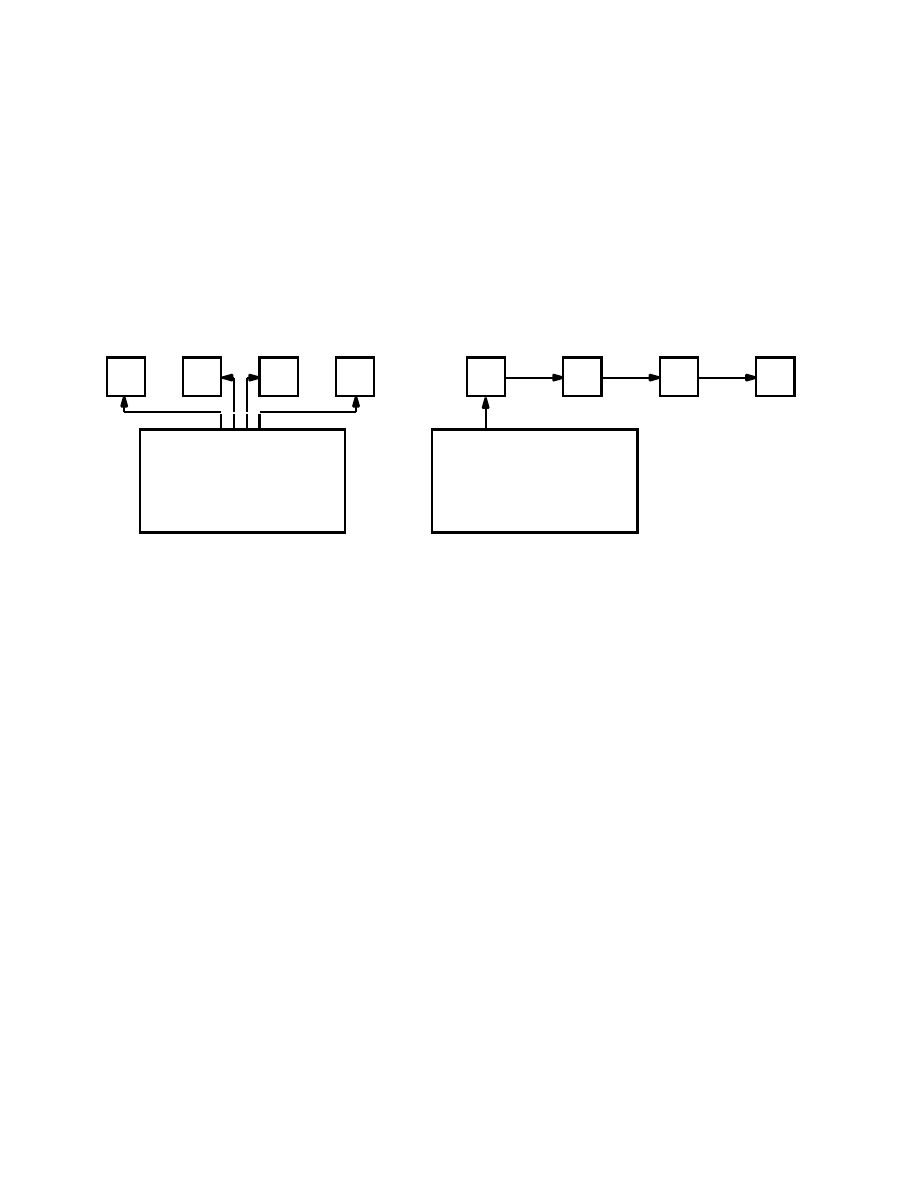ВУЗ: Казахская Национальная Академия Искусств им. Т. Жургенова
Категория: Учебное пособие
Дисциплина: Не указана
Добавлен: 03.02.2019
Просмотров: 12355
Скачиваний: 6

O
overbias: The use of more bias current in an analog magnetic recorder than is required for
maximum sensitivity. Overbias will reduce the distortion and the sensitivity to dropouts, but
will also reduce the high-frequency response, so compensatory equalization must be applied.
overdrive: To input a signal to an audio device in such magnitude that an overload occurs.
Specifically, a characteristic electric guitar sound in which a guitar amplifier (preferably a
tube-type) is overloaded to the point of clipping. A similar result can be provided by an effects
unit of the same name. Not to be confused with fuzz, in which the distortion is introduced be-
fore the amplification stage.
overdub: To record additional parts alongside (or merged with) previous recorded material,
either by a mixing and/or re-recording process or by adding a new track in multitrack re-
cording. Overdubbing enables one-man band productions, as multiple synchronized per-
formances are recorded sequentially. Also called tracking or multitracking.
overflow: MIDI devices invariably have a limited amount of polyphony; any attempt to ex-
ceed this by sending too many simultaneous notes will result in an overflow of MIDI data. If a
device has an overflow facility, Note On messages beyond its total polyphonic capacity are
passed out to a second device for it to voice. Otherwise, the condition results in voice-stealing
.
overlap: The film dialog equivalent of an overdub. (check)
overload: An audio device is overloaded when the input signal level is so high that it drives
the device out if its linear range and into distortion or clipping. Overload may be continuous or
may affect only transients in musical waveforms.
overmodulation: A situation which occurs when the amplitude of a signal exceeds the limits of
the recording or broadcasting system. This causes distortion and can, in exceptional circum-
stances, damage equipment through which the signal passes. The opposite of undermodulation.
overs: Input peaks recorded onto a digital medium in excess of 0VU, causing a crackling, rip-
ping type of distortion. See clipping, headroom.
oversampling: The principle of sampling a signal at an integer multiple of the normal sam-
pling rate. The factor can be as little as two times, or much more. The effect is to distribute a
fixed level of quantization noise over an ultrasonic frequency range, diluting the noise in the
audio bandwidth and improving the S/N ratio. See also quantization error, Shannon’s channel ca-
pacity theorem.
overshoot: (1) (noun) If a compressor or limiter is subjected to a sudden large input signal level,
its attack time may not be fast enough to prevent the output from being momentarily too high.
This initial excessive level is called overshoot, and its severity depends on the speed of the de-
vice. (2) (verb) Imperfect transient response in an audio device will result in the waveform going
past the desired value on fast signal transitions, as is frequently seen on square waves and the
impulse responses of CD players.

O
overtone: Overtones are produced by a musical instrument and are higher in frequency than
the fundamental. They may or may not coincide with the frequencies of a harmonic series. The
overtones define the harmonic spectrum of a sound. The fundamental is the first partial, so the
second partial is the first overtone. Overtones are defined as the harmonics above the funda-
mental, but in common usage they are taken to mean any partials above the fundamental. In
most instruments, the higher overtones are lower in volume than the lower overtones. See
subharmonic.

P
: An abbreviation for phase. Some control consoles have a small switch on their input mod-
ules labeled “
φ
” that inverts the polarity of the signal in that channel. This is to allow all the
signals being mixed together to have the same polarity regardless of wiring errors in patch
panels and microphone cables and in the microphones themselves. See out-of-phase, phase can-
cellation.
PA: (1) Public Address. The distribution of audio signals to loudspeakers for an audience. (2)
A system of equipment, including a mixing desk, amplifiers, loudspeakers, etc., assembled to
provide PA sound.
pad: (1) A switch or knob that lowers the level of an incoming signal before it reaches the rest
of the circuitry. A short name for an attenuator, usually with a fixed amount of insertion loss.
Pads are used between audio devices if there is a danger of the output of one device causing a
signal overload in the input of the other device. An input pad is also called a trim pot. See pot.
(2) A sustained chord part which provides harmonic padding in a piece of popular music. (3)
Drum pads.
paddles: (PEC/Direct)
PAF
:
PAL: Phase-Alternating Line. The UK television broadcast standard. Uses 625 lines at a frame
rate of 25fps.
PAM: Pulse Amplitude Modulation. The first stage in digital sampling, in which pulses of
fixed-width have their amplitude modulated by an analog signal, i.e., the height of the pulse is
determined by the amplitude of the signal. It is followed by an encoding stage known as PCM.
pan: Short for panorama. (1) (noun) Refers to the left-right placement of a sound. (2) (verb)
Moving a sound from stereo-center to one side or the other, either on a mixer or on a synthe-
sizer, sequencer, etc. Usually this is not completely effective as panning alters only the relative
amplitude of the sound left to right, and not the crucial aspect of delay. See Haas effect. (3)
One of the defined MIDI Controller Change messages assigned to the parameter in a synthe-
sizer which determines the stereo image of the sound, effectively making that controller a pan-
pot.
PAN: A dedicated on-line internet service provider for the music industry.
pancake: A 10
1
2
” reel of recording tape without the reel flanges. Recording studios often buy
tape in this form and spool it onto smaller reels as it is used.
panic button: A hardware or software feature that simultaneously sends All Notes Off and
Reset All Controllers commands to a MIDI system. Because some instruments don’t respond
to All Notes Off commands, some panic buttons are designed to send Note Off messages (0-
127) on all channels as well.
panpot: Short for panoramic potentiometer. An audio mixer control which is used for posi-
tioning the channel’s signal somewhere between the right and left speakers. See pan.
paper leader: See plastic leader.

P
parabolic reflector: A dish-shaped structure used to focus sound waves onto a microphone.
The reflector faces the sound source and the microphone is mounted backwards, i.e., pointing
at the center of the parabola. Used mainly to gather sound in outdoor locations, such as in
wildlife recording. A satellite receiving dish for television uses a similar principle to focus in-
coming electromagnetic waves.
parallel: In the connection of one signal or power source to more than one device or destina-
tion, the wiring configuration in which the input leads of all the devices meet at a common
point. Signal or power routed to this point flows directly to each device. The opposite of serial
wiring, in which the source is wired to the input of one device, whose output becomes the in-
put for the next, etc.
Parallel Wiring Topology
OUTPUT
A
B
C
D
Serial Wiring Topology
A
B
C
D
OUTPUT
parallel connection: See bridging.
parallel interface: A protocol for transmitting data whereby all bits in a word (typically two
or more bytes) are sent simultaneously. This method is generally more expensive to imple-
ment than serial protocols as the connectors and cable must have a pin/wire for each bit, plus a
few extra for ground, handshaking, etc. This cost is offset by the faster transmission times.
parallel port: A connector on a PC-type computer which is used to connect devices which use
a parallel interface, such as some MIDI interfaces and parallel printers.
parity check: In digital recording, one or more bits of data derived from the audio sample and
appended to it as a part of the data word. The parity bit allows error-detection circuitry to de-
termine whether the audio bits are correct, and therefore, whether they should be sent on for
D/A conversion, discarded, or repaired. Also called a parity code.
parameter: A user-adjustable quantity that governs some aspect of a device’s performance.
Normally, the settings (values) for all of the parameters that make up a synthesizer patch can
be changed by the user and stored in memory, but the parameters themselves are defined by
the operating system and cannot be altered.
parametric equalizer: A parametric equalizer is a sweep bandpass EQ, except that a third con-
trol is added to allow the Q to be adjusted. Because the filter response is curved, the actual
frequency width is measured in increments of 3dB. Also called a peaking equalizer. See equal-
izer, graphic equalizer.

P
parasitic oscillation: A malfunction occurring in some audio devices, especially power ampli-
fiers, in which the device will generate an ultrasonic signal during a part of the audio signal,
only when the input signal is present and only during part of the audio waveform. Although
the ultrasonic component is not directly audible, its existence modulates the signal, causing
audible distortion and is potentially damaging to tweeters.
partial: The fundamental, harmonic, subharmonic, overtone, or a tone at some other frequency
which forms part of a complex tone. Any component of a sound, whether or not it is an inte-
ger multiple of the fundamental frequency is a partial. The fundamental frequency is the first
partial of a tone.
PASC: See Digital Compact Cassette.
passband: The passband of a filter is the frequency span that the filter passes, or the range of
frequencies not attenuated by the filter. The passband is usually measured between the points
where the response is 3dB down in amplitude relative to the maximum level. See rolloff fre-
quency.
passive: A device is called passive if it contains no amplification circuitry and a signal suffers
insertion loss in passing through it, i.e., more energy goes into the device than is available at its
output. This is opposed to an amplifier or other device which has the potential for at least
unity gain. Many audio equalizers are passive, as are most crossover networks. Passive devices
in general do not add any appreciable nonlinear distortion or noise to the signal, but they have
so much attendant insertion loss that additional amplification is needed, and this always con-
tributes some noise and distortion. Passive devices can and do cause phase distortion, however.
As opposed to active.
passive crossover: See crossover network.
passive equalizer: An equalizer that employs only passive electronic components, i.e., resis-
tors, capacitors, and/or inductors. Since these components require voltage, passive equalizers
can only cut each operating band, the output signal level is necessarily lower than the input
level. See active equalizer.
patch: (1) (verb) To connect together, as the inputs and outputs of various modules, generally
with patch cords. (2) (noun) The configuration of hookups and settings that results from the
process of patching, and by extension, the sound that such a configuration creates. Patch is
most often used to denote a single sound or the contents of a memory location that contains
parameter settings for the sound, even on an instrument that requires no physical patching. A
synonym for sample or program.
patch bay: A group of similar receptacles, or jacks, in an audio system. The act of plugging
and unplugging the patch cords is called patching. Also called a router, jack field, or jack bay.
Increasingly, physical patching is being replaced by digital routing.
patch cord: A short cable, typically fitted with a phone plug or TT connector at each end, used
to make a connection between two points on a patch bay.
patch map: A map with which any incoming MIDI program change message can be assigned
to call up any of an instrument’s patches. This is a table set up by the user with entries such as
1=3, 2=2, 3=984, etc. See patch mapping, MIDI Mapper.